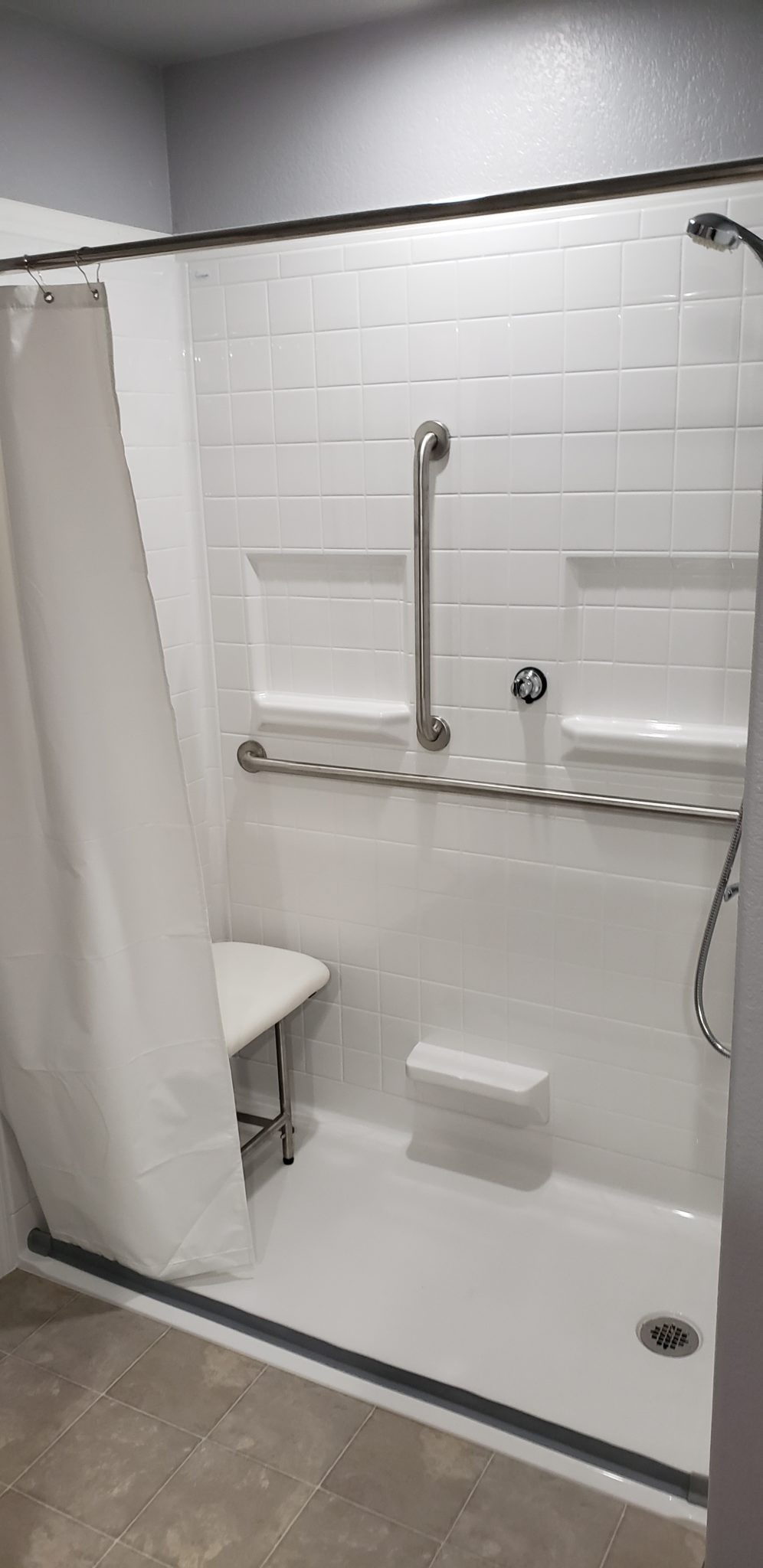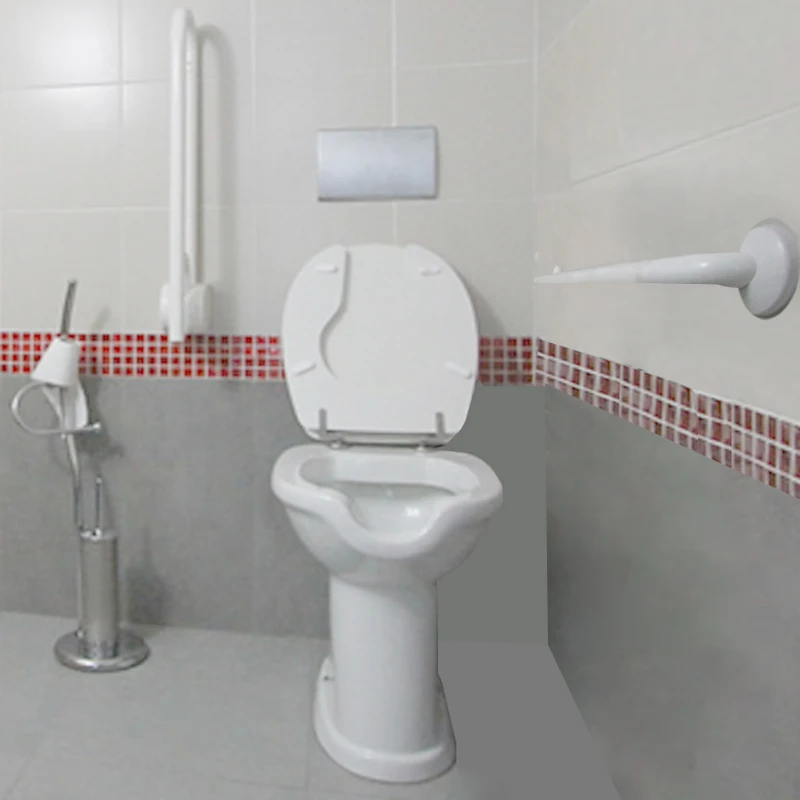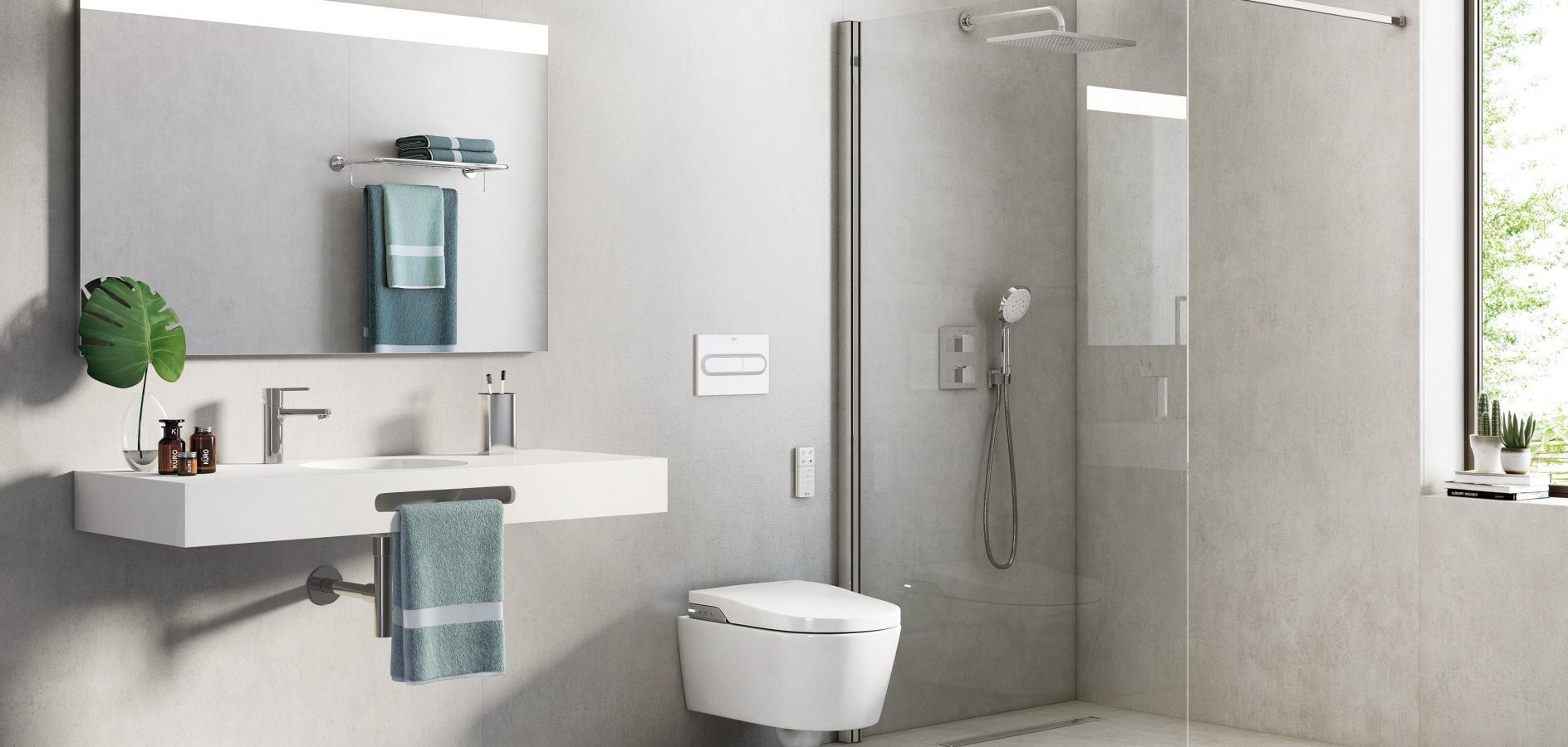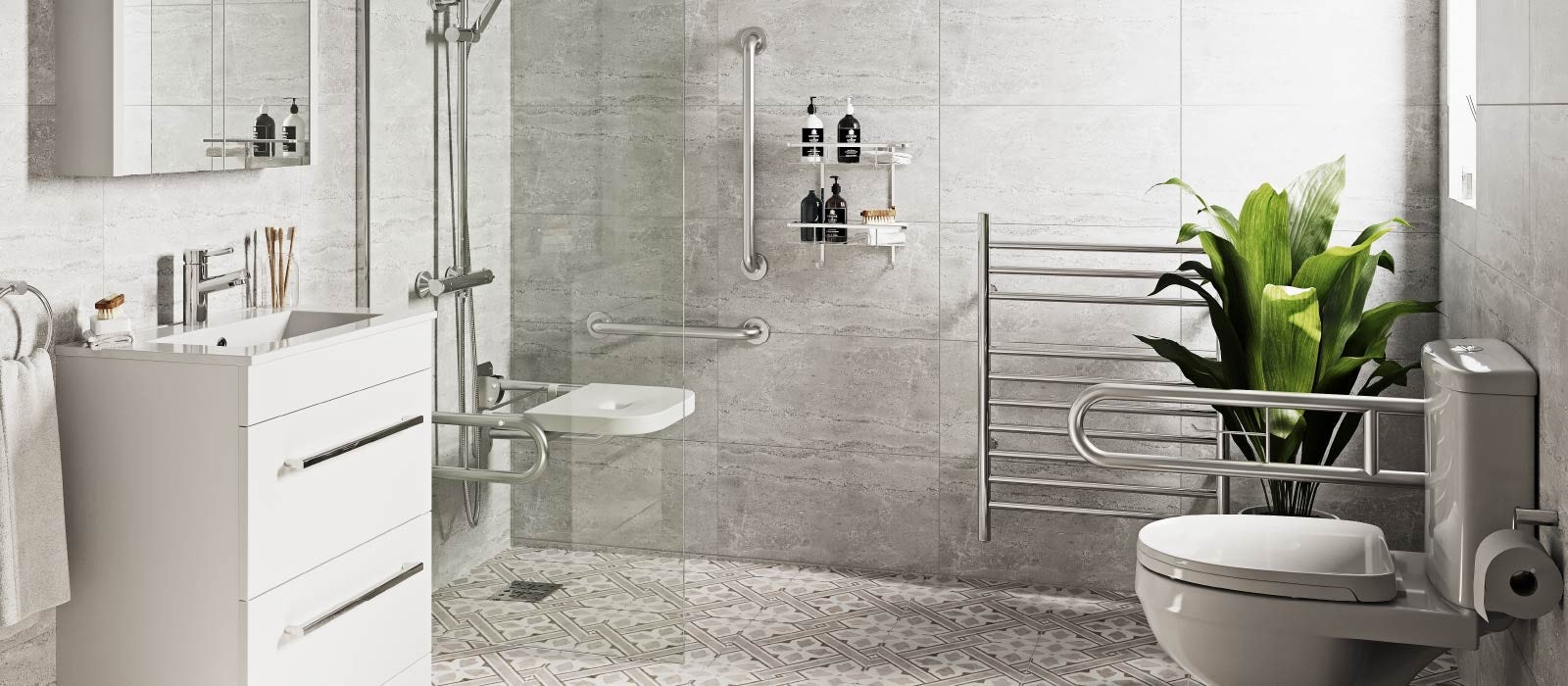Understanding the Importance of Accessibility
Accessibility in bathrooms is crucial for individuals with disabilities or mobility limitations to maintain independence and dignity. Disabled bathroom accessories play a vital role in ensuring that bathrooms are safe, comfortable, and usable for everyone, regardless of their physical abilities. From grab bars to shower seats, these accessories are designed to provide support, stability, and convenience, promoting inclusivity and equality in home and public environments.
- Promoting Independence: Disabled bathroom accessories empower individuals to carry out essential tasks independently, such as bathing, toileting, and personal grooming. By providing support and assistance where needed, these accessories enable individuals to maintain their privacy and dignity, enhancing their overall quality of life.
- Preventing Accidents: Many disabilities or mobility challenges increase the risk of slips, falls, or other accidents in the bathroom. Properly installed grab bars, non-slip mats, and shower seats can significantly reduce these risks by providing stability and support. By creating a safer environment, these accessories help prevent injuries and promote peace of mind for both users and caregivers.
- Ensuring Compliance: Accessibility regulations and guidelines, such as the Americans with Disabilities Act (ADA) in the United States, mandate certain standards for bathroom design in public buildings and accommodations. Installing the appropriate disabled bathroom accessories not only ensures compliance with these regulations but also demonstrates a commitment to inclusivity and social responsibility.
- Improving Comfort and Convenience: Even minor adjustments, such as adjustable-height shower heads or lever handles on faucets, can make a significant difference in the comfort and usability of a bathroom for individuals with disabilities. These accessories cater to specific needs and preferences, allowing users to customize their bathroom experience for maximum comfort and convenience.
- Facilitating Caregiving: Disabled bathroom accessories not only benefit individuals with disabilities but also ease the caregiving process for family members, caregivers, or healthcare professionals. Features like transfer benches, raised toilet seats, and handheld shower sprays simplify tasks such as bathing and toileting, reducing strain and improving efficiency for caregivers.
- Promoting Inclusivity: Accessible bathrooms not only benefit individuals with disabilities but also accommodate diverse needs and preferences, including those related to aging, temporary injuries, or temporary mobility limitations. By incorporating disabled bathroom accessories into residential and commercial spaces, we create environments that are welcoming and inclusive for everyone.

Essential Disabled Bathroom Accessories
Grab Bars
Location: Install grab bars near toilets, showers, and bathtubs to provide support and stability for sitting, standing, and transferring. Horizontal bars next to toilets and vertical bars in showers are commonly recommended for optimal accessibility.
Material and Finish: Choose grab bars made of durable materials such as stainless steel or coated aluminum, which are resistant to rust and corrosion. Opt for finishes that blend seamlessly with the bathroom decor while providing a non-slip surface for gripping.
Installation: Proper installation is crucial to ensure the strength and stability of grab bars. Securely anchor them to structural supports in the wall, using reinforcement if necessary. Follow manufacturer guidelines and ADA requirements for height, spacing, and weight capacity.
Shower Seats
Type: Select shower seats based on the user’s specific needs and space constraints. Wall-mounted fold-down seats are ideal for compact bathrooms, while freestanding or transfer benches provide flexibility and support for users with mobility challenges.
Material: Choose shower seats made of waterproof and easy-to-clean materials such as teak, plastic, or phenolic resin. These materials are resistant to moisture and mold, ensuring durability and hygiene in wet environments.
Height and Stability: Ensure that the shower seat is at a comfortable height for the user to sit and stand safely. Verify that it is securely anchored to the wall or floor to prevent tipping or sliding during use.
Toilet Accessories
Raised Toilet Seats: Raised toilet seats provide additional height for individuals with mobility limitations or difficulty bending. Choose seats with armrests for added support and stability during transfers.
Grab Bars: Install grab bars near toilets to assist with sitting, standing, and balancing. Vertical bars on either side of the toilet and a horizontal bar behind it are recommended for optimal support.
Bidet Attachments: Bidet attachments offer a hygienic alternative to traditional toilet paper and can be particularly beneficial for individuals with limited mobility or dexterity. Choose models with adjustable water pressure and temperature for personalized comfort.
Non-Slip Flooring and Mats
Flooring: Select non-slip flooring materials such as textured tiles, vinyl, or rubber, which provide traction and stability, even when wet. Avoid smooth or glossy surfaces that can become slippery and hazardous.
Bath Mats: Use non-slip bath mats inside showers and tubs to reduce the risk of slips and falls. Ensure that mats have suction cups or a textured surface to adhere securely to the floor.
Color Contrast: Enhance visibility and safety by choosing bath mats in contrasting colors to the surrounding flooring. This helps individuals with visual impairments identify changes in surface elevation and navigate the bathroom more confidently.
Faucets and Controls
Lever Handles: Replace traditional knob-style faucet handles with lever handles, which are easier to grip and manipulate, especially for users with limited hand strength or dexterity. Lever handles require less effort to operate and can be operated using various hand positions.
Touchless Controls: Consider installing touchless or motion-activated faucets, soap dispensers, and hand dryers to minimize physical contact and reduce the spread of germs. These features are particularly beneficial for individuals with mobility or hygiene challenges.
Temperature Regulation: Ensure that faucets and shower controls have temperature-limiting features to prevent scalding injuries. Adjustable thermostatic valves or anti-scald devices maintain a safe and comfortable water temperature, even if there are fluctuations in water pressure or supply.
Common Mistakes to Avoid with Disabled Bathroom Accessories
Improper Installation
Issue: Failing to install disabled bathroom accessories correctly can compromise their effectiveness and safety. Inadequately anchored grab bars or unstable shower seats pose hazards to users and may fail to provide the necessary support.
Solution: Follow manufacturer guidelines and ADA requirements for installation, including proper anchoring to structural supports in the wall or floor. Consider hiring a professional installer with experience in accessible bathroom design to ensure compliance and safety.
Inadequate Maintenance
Issue: Neglecting regular maintenance of disabled bathroom accessories can lead to deterioration, malfunction, or hygiene issues. Dirty or damaged grab bars, shower seats, or non-slip mats may pose health risks and diminish usability.
Solution: Establish a routine maintenance schedule for cleaning and inspecting disabled bathroom accessories, paying attention to areas prone to moisture buildup or wear. Replace worn or damaged accessories promptly to maintain safety and hygiene standards.
Lack of User Input
Issue: Designing or selecting disabled bathroom accessories without considering the preferences and needs of the intended users can result in ineffective or unsuitable solutions. Accessories that do not meet the user’s specific requirements may be difficult to use or uncomfortable.
Solution: Involve individuals with disabilities or mobility limitations in the decision-making process when choosing and installing bathroom accessories. Solicit feedback on preferences, challenges, and priorities to ensure that the selected accessories meet their needs and enhance their independence and comfort.
Overlooking Accessibility Features
Issue: Choosing standard bathroom fixtures or accessories without considering accessibility features can create barriers for individuals with disabilities. Traditional faucets, toilets, or showers may be difficult or impossible for users with mobility limitations to use safely and comfortably.
Solution: Prioritize accessibility features when selecting bathroom fixtures and accessories, such as lever handles, raised toilets, adjustable shower heads, and touchless controls. Ensure that these features are integrated seamlessly into the bathroom design to enhance usability without compromising aesthetics.
Neglecting Aesthetic Integration
Issue: Installing disabled bathroom accessories that clash with the overall design or appear too institutional can make the bathroom less inviting and aesthetically pleasing. Accessories that look out of place may detract from the bathroom’s visual appeal.
Solution: Choose disabled bathroom accessories that complement the bathroom’s decor and design theme. Many modern accessibility products are available in a variety of styles, finishes, and colors to blend seamlessly with contemporary, traditional, or eclectic designs.
Inadequate Planning
Issue: Failing to plan the layout and placement of disabled bathroom accessories properly can lead to inefficient use of space and awkward or inaccessible configurations. Poor planning may result in inadequate support or maneuverability for users.
Solution: Plan the layout of disabled bathroom accessories with consideration for the user’s specific needs, mobility aids, and typical bathroom routines. Ensure there is adequate space for movement, and that accessories are placed within easy reach and at appropriate heights.
Types of Disabled Bathroom Accessories
Grab Bars
Purpose and Function: Grab bars provide essential support for individuals with mobility challenges, assisting with sitting, standing, and moving around the bathroom. They offer stability and help prevent falls, especially in wet or slippery areas.
Variety: Grab bars come in various lengths, diameters, and configurations to suit different areas and needs. Straight bars, angled bars, and U-shaped bars are commonly used in bathrooms to provide support in different directions.
Materials: High-quality grab bars are typically made of materials like stainless steel, plastic, or coated aluminum. These materials are durable, corrosion-resistant, and capable of supporting significant weight.
Aesthetic Options: Modern grab bars are available in a range of finishes, including chrome, brushed nickel, and matte black. This variety allows them to blend with various bathroom styles, from contemporary to classic.
Installation Tips: Install grab bars securely into wall studs or use appropriate wall anchors if studs are not available. Follow ADA guidelines for placement, typically 33-36 inches from the floor for horizontal bars and 18-24 inches for vertical bars.
Safety Standards: Ensure grab bars meet ADA standards for strength and weight capacity, which typically require bars to support at least 250 pounds. Check local building codes for specific requirements.
Shower Seats and Benches
Purpose: Shower seats and benches provide a safe and comfortable place to sit while bathing, reducing the risk of slips and falls. They are especially beneficial for individuals with balance issues, fatigue, or difficulty standing for long periods.
Types: Options include wall-mounted fold-down seats, freestanding benches, and transfer benches. Wall-mounted seats are ideal for compact showers, while freestanding benches offer flexibility and can be moved as needed.
Materials: Shower seats are often made from water-resistant materials such as teak, plastic, or phenolic resin. These materials are durable and easy to clean, withstanding the moist environment of a bathroom.
Adjustability: Some shower seats feature adjustable heights or foldable designs to accommodate different users and save space when not in use. Ensure the seat is stable and secure at any adjusted height.
Installation Considerations: Wall-mounted seats should be securely anchored to structural supports in the wall. For freestanding benches, ensure they have non-slip feet to prevent sliding.
Hygiene and Maintenance: Regularly clean and inspect shower seats for signs of wear or damage. Replace any components that show signs of deterioration to maintain safety and hygiene.
Raised Toilet Seats
Function: Raised toilet seats increase the height of the toilet, making it easier for individuals with limited mobility or strength to sit down and stand up. They reduce the need for bending and provide additional support during transfers.
Types: Raised toilet seats can be attached to the existing toilet bowl or come as a complete unit with armrests and a higher seat. Some models feature padding for added comfort.
Materials: Typically made from durable plastic or molded foam, raised toilet seats are designed to withstand frequent use and are easy to clean. Look for materials that offer both strength and comfort.
Features: Many raised toilet seats include additional features like armrests, lids, or quick-release mechanisms for easy removal. Choose features that enhance the user’s comfort and convenience.
Installation: Ensure the raised toilet seat is securely attached to the toilet bowl, with mechanisms that prevent shifting or slipping. Follow manufacturer instructions for proper installation and use.
Accessibility: Raised toilet seats should meet ADA height requirements, typically 17-19 inches from the floor to the top of the seat. Ensure they are compatible with the existing toilet and provide adequate stability.
Handheld Shower Heads
Purpose: Handheld shower heads offer greater flexibility and control during bathing, allowing users to direct water where needed. They are particularly useful for individuals with limited mobility, enabling easier rinsing and cleaning.
Types: Handheld shower heads come in various designs, including single-function, multi-function, and those with adjustable spray settings. Choose a model that meets the user’s specific needs and preferences.
Mounting Options: Many handheld shower heads come with a wall-mounted bracket or slide bar, allowing users to adjust the height and angle of the shower head. This feature is beneficial for seated users or those who need to shower while standing.
Hose Length: Opt for a shower head with a long, flexible hose (at least 5-6 feet) to provide ample reach and maneuverability. Ensure the hose is durable and resistant to kinking or tangling.
Water Control: Consider models with easy-to-use controls, such as lever or push-button mechanisms, for adjusting water flow and temperature. These controls should be accessible and operable with limited hand strength.
Installation: Handheld shower heads are typically easy to install, often attaching to existing shower plumbing without the need for major modifications. Follow manufacturer instructions for secure installation.
Cleaning and Maintenance: Regularly clean the shower head to prevent mineral buildup and maintain water flow. Check hoses and connections for signs of wear and replace as needed.
Non-Slip Flooring and Mats
Purpose: Non-slip flooring and mats are essential for preventing slips and falls in the bathroom, especially in wet areas like showers and bathtubs. They provide traction and stability for individuals with mobility challenges.
Materials: Non-slip mats are often made from rubber, vinyl, or textured materials that provide grip even when wet. Choose materials that are durable, easy to clean, and resistant to mold and mildew.
Placement: Place non-slip mats inside showers, bathtubs, and at the entrance to the bathroom to provide secure footing. Ensure that mats adhere securely to the floor and do not shift or bunch up.
Features: Look for mats with suction cups or adhesive backing to prevent movement. Some mats also feature drainage holes to allow water to flow through, reducing the risk of standing water and slippage.
Color and Contrast: Choose mats in colors that contrast with the surrounding flooring to enhance visibility. This is especially important for individuals with visual impairments, helping them identify safe walking areas.
Maintenance: Regularly clean non-slip mats to remove soap scum, mold, and mildew. Inspect mats for wear and replace them if they become damaged or lose their grip.
Installation: Follow manufacturer guidelines for securing non-slip mats in place. Ensure that mats are properly positioned and do not create tripping hazards by curling at the edges.
Designing an Accessible Bathroom
Layout Considerations
Space Requirements: Ensure the bathroom has sufficient space for maneuvering, especially for users with mobility aids such as wheelchairs or walkers. ADA guidelines recommend a minimum turning radius of 60 inches for wheelchairs.
Clearance: Provide adequate clearance around fixtures like toilets, sinks, and showers to allow for easy access and transfers. Clear space under sinks allows for wheelchair access, and wider doorways (at least 32 inches) facilitate entry and exit.
Fixtures Placement: Position fixtures such as grab bars, shower seats, and controls within easy reach and at appropriate heights for the user. Ensure that these fixtures do not obstruct movement or create hazards.
Storage Solutions: Incorporate accessible storage options, such as pull-out shelves or wall-mounted cabinets, that are easy to reach without bending or stretching. Consider the needs of the user when designing storage solutions to ensure convenience and accessibility.
Lighting: Provide adequate lighting, especially in areas used for grooming or medication management. Use a combination of natural and artificial lighting, with adjustable options to cater to different needs and preferences.
Safety Features: Incorporate additional safety features such as anti-scald valves, emergency alarms, and water temperature monitors. These features enhance safety and provide peace of mind for users and caregivers.
Fixture Selection
Toilets: Choose accessible toilets with higher seat heights (17-19 inches) to facilitate sitting and standing. Consider models with side handles or integrated bidet features for additional support and hygiene.
Sinks and Vanities: Opt for wall-mounted sinks with knee clearance underneath for wheelchair access. Ensure that faucets are within easy reach and that hot water pipes are insulated to prevent burns.
Showers: Select walk-in showers or roll-in showers with low or no thresholds to accommodate users with mobility aids. Include built-in or wall-mounted shower seats and handheld shower heads for convenience.
Bathtubs: For users who prefer bathtubs, consider walk-in models with low entry steps and built-in seating. Ensure that grab bars and non-slip surfaces are installed to provide support and prevent slipping.
Faucets and Controls: Use lever handles or touchless controls for faucets to accommodate users with limited hand strength or dexterity. Ensure that water temperature controls are easy to adjust and have anti-scald features.
Flooring and Surfaces
Non-Slip Flooring: Opt for non-slip flooring materials such as textured tiles, vinyl, or rubber, which offer traction and stability even when wet. These materials help prevent slips and falls, making the bathroom safer for individuals with mobility challenges.
Water Resistance: Ensure that flooring materials are water-resistant to prevent damage and reduce the risk of mold and mildew. Choose surfaces that are easy to clean and maintain to ensure a hygienic environment.
Color Contrast: Use contrasting colors for flooring and walls to enhance visibility and help individuals with visual impairments distinguish between different surfaces. This improves navigation and safety within the bathroom.
Thresholds: Minimize or eliminate thresholds at the entrance to the bathroom and shower to facilitate access for wheelchairs or walkers. Ensure that any transitions between different flooring materials are smooth and level.
Textured Surfaces: Consider adding textured surfaces in areas prone to moisture, such as near sinks and bathtubs. These surfaces provide additional grip and reduce the likelihood of slipping.
Mat Placement: Strategically place non-slip mats in high-risk areas, such as inside the shower, bathtub, and in front of the sink. Ensure mats are securely anchored to prevent them from shifting or creating tripping hazards.
Lighting Solutions
Task Lighting: Install task lighting around mirrors and sinks to provide clear, focused illumination for activities such as grooming and medication management. Use adjustable or dimmable lights to accommodate different needs.
Ambient Lighting: Use ambient lighting to create a well-lit environment throughout the bathroom. Consider recessed ceiling lights, wall sconces, or LED strips for even distribution of light.
Accent Lighting: Incorporate accent lighting to highlight architectural features, decor, or specific areas. This adds depth and visual interest, enhancing both the functionality and aesthetics of the bathroom.
Natural Light: Maximize natural light by using windows, skylights, or solar tubes. Ensure privacy with frosted glass or window treatments that allow light in while maintaining discretion.
Lighting Controls: Use accessible lighting controls, such as large switches or remote controls, to allow easy operation for individuals with limited dexterity. Consider motion-activated lights for areas like closets or under-cabinets.
Safety Lighting: Install night lights or low-level lighting to guide users safely during nighttime visits. These lights provide visibility without being too harsh or disrupting sleep.
Accessibility Standards
ADA Compliance: Follow ADA guidelines for the placement, height, and specifications of bathroom fixtures and accessories. These guidelines ensure that the bathroom is accessible and usable for individuals with disabilities.
Local Building Codes: Check local building codes and regulations for additional accessibility requirements. Compliance with these codes ensures that the bathroom meets safety and accessibility standards.
User-Centered Design: Design the bathroom with the user’s specific needs and preferences in mind. Consider factors such as mobility aids, reach, and the ability to operate fixtures and controls independently.
Ergonomics: Ensure that the design and placement of fixtures accommodate the user’s natural movements and reduce strain. Features such as adjustable-height shower heads and easily reachable storage enhance usability.
Universal Design: Aim for a universal design approach that makes the bathroom accessible to all users, regardless of age or ability. This approach promotes inclusivity and ensures that the space is functional for a diverse range of needs.
Continuous Evaluation: Regularly assess and update the bathroom to accommodate changing needs or advancements in accessibility technology. This ongoing evaluation ensures that the bathroom remains safe, functional, and comfortable over time.
Related Posts:
- Lone Star Bathroom Accessories
- Seagrass Bathroom Accessories
- Bathroom Accessories Set With Tray
- Fancy Bathroom Accessories
- Square Bathroom Accessories
- Glass And Chrome Bathroom Accessories
- Raspberry Bathroom Accessories
- Ada Bathroom Accessories Heights
- Barbara Barry Bathroom Accessories
- Peacock Blue Bathroom Accessories







